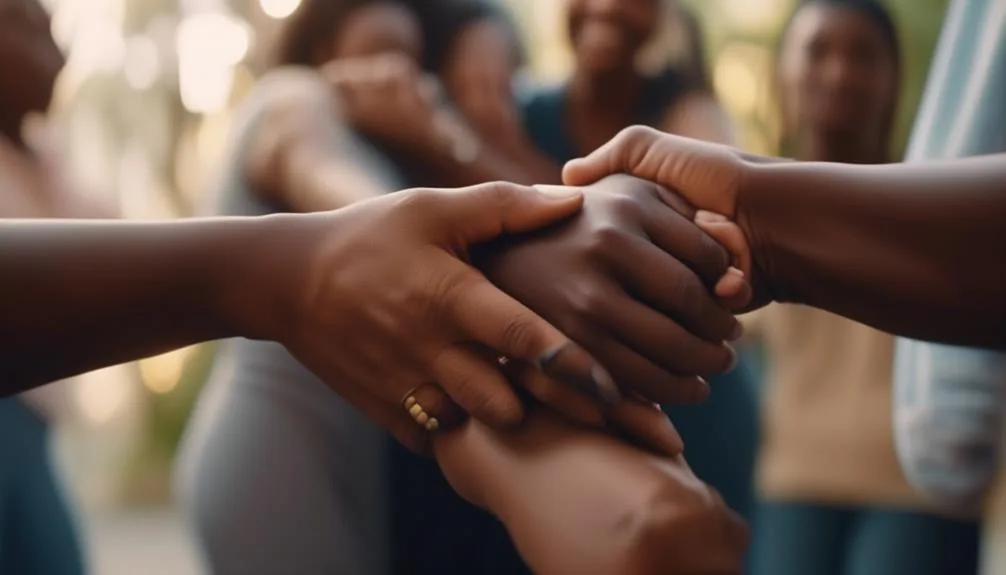Groundbreaking Theory Unlocks Secrets of Human Attachment
Like a key that unlocks a hidden treasure trove, the groundbreaking theory of human attachment unveils the secrets that lie within our most intimate relationships. Prepare to be captivated as you explore the depths of this transformative theory, shedding light on the profound impact of early bonds and the development of trust.
From the origins of attachment theory to its practical applications in therapy and relationship counseling, this discussion will take you on a journey that will forever change the way you perceive human connections.
Get ready to embark on a quest that will reveal the hidden intricacies of human attachment and leave you yearning for more.
Key Takeaways
- Bowlby and Ainsworth collaborated in developing attachment theory, which focuses on the impact of family experiences on children's wellbeing.
- Attachment theory consists of four stages: pre-attachment, attachment-in-the-making, clear-cut attachment, and formation of reciprocal relationships.
- The development of secure attachments with primary caregivers is crucial for the child's trust and healthy relationships later in life.
- Attachment theory has practical applications in therapy, parenting, relationship counseling, and understanding grief, trauma, and loss.
The Origins of Attachment Theory

The origins of attachment theory can be traced back to the collaborative efforts of John Bowlby and Mary Ainsworth, who sought to understand the impact of early family experiences on a child's overall well-being.
Bowlby's early influences, including his work with children separated from their families during World War II, sparked his interest in child development and the importance of secure attachments.
Ainsworth made significant contributions to attachment theory through her study of security theory and the development of the Strange Situation procedure. This groundbreaking research allowed for the identification and classification of different attachment styles.
Together, Bowlby and Ainsworth revolutionized our understanding of the critical role that early relationships play in shaping a child's emotional and social development.
Their collaborative efforts laid the foundation for attachment theory, which continues to be influential in various fields, including psychology, education, and social work.
Bowlby and Ainsworth: Collaborative Breakthroughs

Building upon their earlier research and findings, Bowlby and Ainsworth collaborated to make groundbreaking breakthroughs in the field of attachment theory. Their research collaboration has had a significant impact on our understanding of child development and the importance of secure attachments in early life. Here are three key contributions they made:
- Development of the Strange Situation Procedure: Bowlby and Ainsworth developed the Strange Situation Procedure, a standardized assessment tool used to observe and classify infant attachment behaviors. This procedure allowed researchers to identify different attachment styles and understand how they develop.
- Identification of attachment styles: Through their research, Bowlby and Ainsworth identified four main attachment styles: secure, anxious-ambivalent, avoidant, and disorganized. These styles provide insight into how children form relationships and cope with separation, which has important implications for their emotional and social development.
- Validation of attachment theory: Bowlby and Ainsworth's research provided empirical evidence supporting the validity of attachment theory. Their studies demonstrated the impact of early attachment experiences on later development, including social and emotional functioning, forming relationships, and resilience.
The Four Stages of Attachment
In understanding human attachment theory, it's important to explore the four stages that individuals go through in the development of their attachments.
These stages are pre-attachment, attachment-in-the-making, clear-cut attachment, and formation of reciprocal relationships.
During the pre-attachment stage, which occurs from birth to around 6 weeks, infants aren't yet attached to a specific caregiver and show no preference for one person over another.
The attachment-in-the-making stage, from 6 weeks to around 6-8 months, is characterized by infants starting to show preference for familiar caregivers.
Clear-cut attachment, from around 6-8 months to 18 months to 2 years, is when infants actively seek proximity and contact with their primary caregiver.
Finally, in the formation of reciprocal relationships stage, which occurs around 2 years and beyond, children develop stronger cognitive and social skills, and their attachments become more complex.
The role of primary caregivers in attachment development is crucial. They provide a secure base for exploration, emotional support, and consistent responsiveness, which helps foster a secure attachment style in childhood and adulthood.
Attachment Theory's Impact on Relationships

Attachment theory has a significant impact on the formation and maintenance of human relationships throughout the lifespan. Understanding attachment styles in friendships is crucial for building and maintaining strong connections. People with secure attachment styles tend to have more trusting and fulfilling friendships, while those with insecure attachment styles may struggle with trust, intimacy, and emotional availability.
Attachment theory also plays a role in workplace relationships. Employees with secure attachment styles are more likely to have positive interactions with colleagues, exhibit effective communication skills, and experience higher job satisfaction. On the other hand, individuals with insecure attachment styles may struggle with teamwork, conflict resolution, and adapting to changes in the work environment.
Practical Applications of Attachment Theory

The practical applications of attachment theory extend beyond personal relationships, shaping various aspects of our lives, including therapy, parenting, and relationship counseling.
Attachment theory in therapy involves understanding how early attachment experiences influence an individual's emotional and relational patterns. Therapists can help clients explore and process their attachment history, which can lead to greater awareness and healing.
Attachment theory in parenting provides insights into how caregivers can foster secure attachments with their children, promoting healthy emotional development and resilience. Parents can learn strategies to attune to their child's needs, provide a safe and nurturing environment, and promote a secure base for exploration.
Criticisms and Further Resources

One common criticism of attachment theory is its limited focus on cultural and contextual factors, which may influence attachment styles and behaviors. While attachment theory emphasizes the role of nurture in shaping attachments, it tends to overlook the influence of cultural and contextual factors on attachment processes.
Here are three key points to consider:
- Overemphasis on nurture: Attachment theory places significant emphasis on the role of caregivers in shaping attachment styles. However, it fails to adequately account for the influence of genetic factors and other biological predispositions that may contribute to attachment behaviors.
- Cultural and contextual factors: Attachment styles and behaviors can vary across different cultures and contexts. Factors such as societal norms, parenting practices, and social support systems can significantly impact attachment processes. Ignoring these factors limits the generalizability of attachment theory.
- Need for a broader perspective: To fully understand attachment processes, it's important to consider the interplay between individual, cultural, and contextual factors. A more comprehensive approach would involve integrating cultural and contextual factors into attachment theory to provide a more nuanced understanding of human attachment.
Further research and exploration of cultural and contextual factors can help refine attachment theory and enhance its applicability across diverse populations.
Frequently Asked Questions
What Are the Key Studies and Research That Contributed to the Validation of Attachment Theory?
Key studies and research have validated attachment theory by examining the role of attachment in understanding human relationships. These studies provide evidence of the importance of secure attachments in forming and maintaining healthy relationships throughout life.
How Does Attachment Theory Explain the Impact of Early Family Experiences on Children's Wellbeing?
Attachment theory explains how early family experiences, such as parental divorce, can impact children's attachment. It also shows that early trauma can influence attachment styles, leading to insecure attachments later in life.
What Are the Characteristics and Behaviors Exhibited During the Pre-Attachment Stage of Attachment?
During the pre-attachment stage, you exhibit behaviors such as reflexive smiling, crying, and vocalizations. Your characteristics include being comforted by anyone and not displaying a preference for a specific caregiver.
How Does Attachment Theory Explain the Influence of Attachment Styles in Childhood on Adult Intimate and Romantic Relationships?
Attachment theory explains how your attachment style in childhood influences your adult intimate and romantic relationships. It highlights the role of attachment styles in adulthood and how they shape relationship dynamics.
What Are Some Practical Applications of Attachment Theory in Therapy, Parenting, and Relationship Counseling?
Attachment theory in therapy, parenting, and relationship counseling can be applied through secure base therapy and attachment-based interventions. These approaches focus on creating a safe and supportive environment, promoting secure attachments, and addressing the impact of attachment styles on relationships.
Conclusion
In conclusion, attachment theory has revolutionized our understanding of human relationships, shedding light on the profound impact that early attachments have on our lives.
By exploring Bowlby's four stages of attachment, we gain valuable insights into the development of trust and secure attachments.
Furthermore, attachment styles established in childhood continue to influence our adult relationships.
This groundbreaking theory has practical applications in therapy, parenting, and relationship counseling.
As we unlock the secrets of human attachment, we uncover the transformative power of understanding and nurturing these vital connections.






